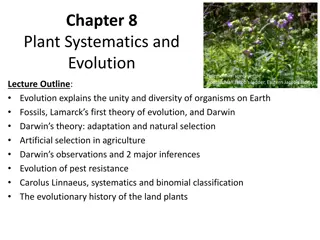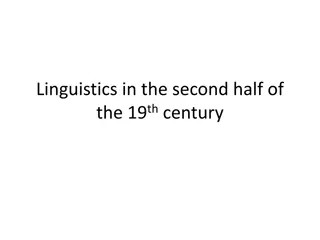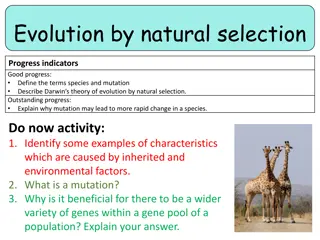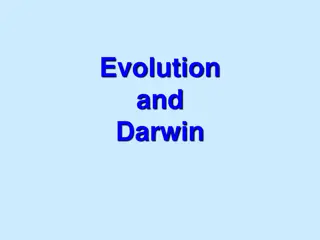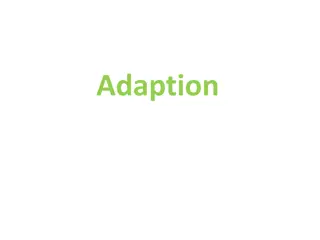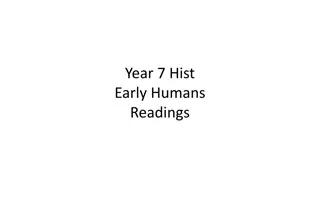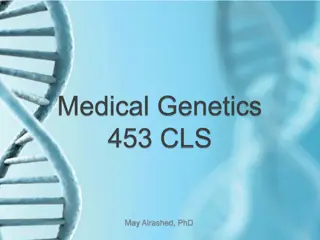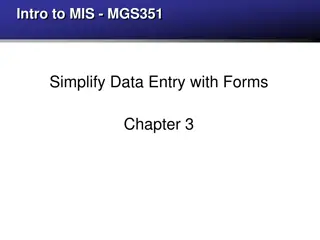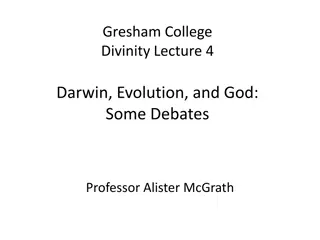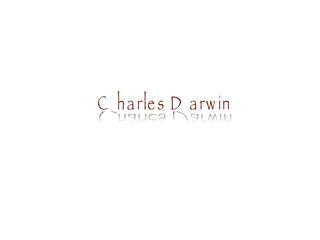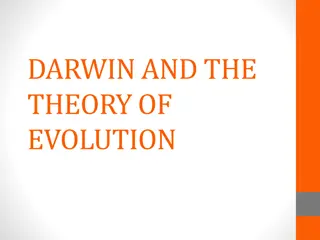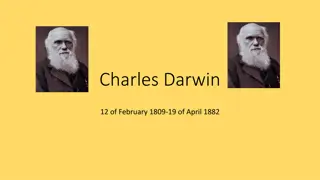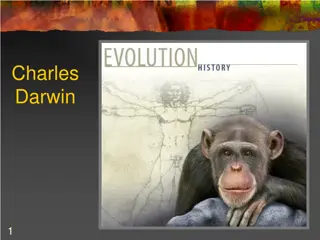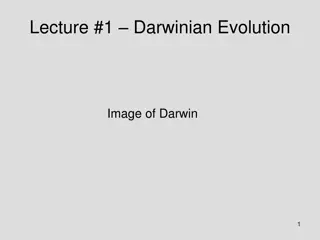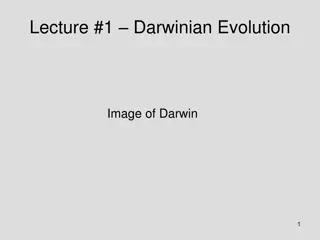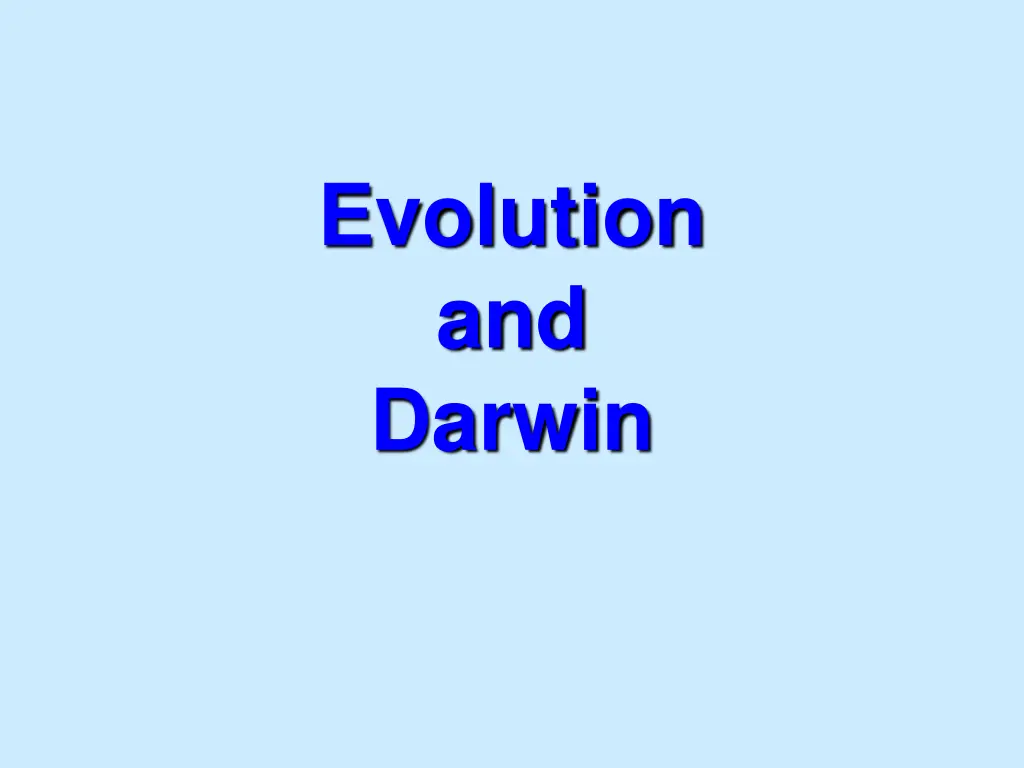
Understanding Evolution and Darwin's Theories
Explore the concepts of evolution and Darwin's theories, including the processes that have shaped life on Earth, old theories of evolution, the inheritance of acquired characteristics, Charles Darwin's influential journey, and the principles of natural selection. Discover the importance of adaptation and the impact of these evolutionary ideas on the scientific community.
Download Presentation

Please find below an Image/Link to download the presentation.
The content on the website is provided AS IS for your information and personal use only. It may not be sold, licensed, or shared on other websites without obtaining consent from the author. If you encounter any issues during the download, it is possible that the publisher has removed the file from their server.
You are allowed to download the files provided on this website for personal or commercial use, subject to the condition that they are used lawfully. All files are the property of their respective owners.
The content on the website is provided AS IS for your information and personal use only. It may not be sold, licensed, or shared on other websites without obtaining consent from the author.
E N D
Presentation Transcript
Evolution and Darwin
Evolution The processes that have transformed life on earth from it s earliest forms to the vast diversity that characterizes it today. A change in the genes!!!!!!!!
Old Theories of Evolution Jean Baptiste Lamarck (early 1800 s) proposed: The inheritance of acquired characteristics He proposed that by using or not using its body parts, an individual tends to develop certain characteristics, which it passes on to its offspring.
The Inheritance of Acquired Characteristics Example: A giraffe acquired its long neck because its ancestor stretched higher and higher into the trees to reach leaves, and that the animal s increasingly lengthened neck was passed on to its offspring.
Charles Darwin Influenced by Charles Lyell who published Principles of Geology . This publication led Darwin to realize that natural forces gradually change Earth s surface and that the forces of the past are still operating in modern times.
Charles Darwin Darwin set sail on the H.M.S. Beagle (1831-1836) to survey the south seas (mainly South America and the Galapagos Islands) to collect plants and animals. On the Galapagos Islands, Darwin observed species that lived no where else in the world. These observations led Darwin to write a book.
Charles Darwin Wrote in 1859: by Means of Natural Selection On the Origin of Species Two main points: 1. Species were not created in their present form, but evolved from ancestral species. 2. Proposed a mechanism for evolution: NATURAL SELECTION
Natural Selection Individuals with favourable traits are more likely to leave more offspring better suited for their environment. Also known as Differential Reproduction Example: English peppered moth (Biston betularia) - light and dark phases
Artificial Selection The selective breeding of domesticated plants and animals by man. Question: What s the ancestor of the domesticated dog? Answer: WOLF
Evidence of Evolution 1. Biogeography: Geographical distribution of species. 2. Fossil Record: Fossils and the order in which they appear in layers of sedimentary rock (strongest evidence).
Evidence of Evolution 3. Taxonomy: Classification of life forms. 4. Homologous structures: Structures that are similar because of common ancestry (comparative anatomy)
Evidence of Evolution 5. Comparative embryology: Study of structures that appear during embryonic development. 6. Molecular biology: DNA and proteins (amino acids)
Population Genetics The science of genetic change in population. Remember: Hardy-Weinberg equation.(A level only)
Population A localized group of individuals belonging to the same species.
Species A group of populations whose individuals have the potential to interbreed and produce viable offspring. GCSE stop
Gene Pool The total collection of genes in a population at any one time.
Hardy-Weinberg Principle The concept that the shuffling of genes that occur during sexual reproduction, by itself, cannot change the overall genetic makeup of a population.
Hardy-Weinberg Principle This principle will be maintained in nature only if all five of the following conditions are met: 1. Very large population 2. Isolation from other populations 3. No net mutations 4. Random mating 5. No natural selection
Hardy-Weinberg Principle Remember: If these conditions are met, the population is at equilibrium. This means No Change or No Evolution .
Macroevolution The origin of taxonomic groups higher than the species level.
Microevolution A change in a population s gene pool over a secession of generations. Evolutionary changes in species over relatively brief periods of geological time.
Five Mechanisms of Microevolution 1. Genetic drift: Change in the gene pool of a small population due to chance. Two examples: a. Bottleneck effect b. Founder effect
a. Bottleneck Effect Genetic drift (reduction of alleles in a population) resulting from a disaster that drastically reduces population size. Examples: 1. Earthquakes 2. Volcanoes
b. Founder Effect Genetic drift resulting from the colonization of a new location by a small number of individuals. Results in random change of the gene pool. Example: 1. Islands (first Darwin finch)
Five Mechanisms of Microevolution 2. Gene Flow: The gain or loss of alleles from a population by the movement of individuals or gametes. Immigration or emigration.
Five Mechanisms of Microevolution 3. Mutation: Change in an organism s DNA that creates a new allele. 4. Non-random mating: The selection of mates other than by chance. 5. Natural selection: Differential reproduction.
Modes of Action Natural selection has three modes of action: 1. Stabilizing selection 2. Directional selection 3. Diversifying selection Number of Individuals Small Large Size of individuals
1. Stabilizing Selection Acts upon extremes and favors the intermediate. Number of Individuals Small Large Size of individuals
2. Directional Selection Favors variants of one extreme. Number of Individuals Small Large Size of individuals
3. Diversifying Selection Favors variants of opposite extremes. Number of Individuals Small Large Size of individuals
Speciation The evolution of new species.
Reproductive Barriers Any mechanism that impedes two species from producing fertile and/or viable hybrid offspring. Two barriers: 1. Pre-zygotic barriers 2. Post-zygotic barriers
1. Pre-zygotic Barriers a. Temporal isolation: Breeding occurs at different times for different species. b. Habitat isolation: Species breed in different habitats. c. Behavioral isolation: Little or no sexual attraction between species.
1. Pre-zygotic Barriers d. Mechanical isolation: Structural differences prevent gamete exchange. e. Gametic isolation: Gametes die before uniting with gametes of other species, or gametes fail to unite.
2. Post-zygotic Barriers a. Hybrid inviability: Hybrid zygotes fail to develop or fail to reach sexual maturity. b. Hybrid sterility: Hybrid fails to produce functional gametes. c. Hybrid breakdown: Offspring of hybrids are weak or infertile.
Allopatric Speciation Induced when the ancestral population becomes separated by a geographical barrier. Example: Grand Canyon and ground squirrels
Adaptive Radiation Emergence of numerous species from a common ancestor introduced to new and diverse environments. Example: Darwin s Finches
Sympatric Speciation Result of a radical change in the genome that produces a reproductively isolated sub- population within the parent population (rare). Example: Plant evolution - polyploid A species doubles it s chromosome # to become tetraploid. Parent population reproductive sub-population
Interpretations of Speciation Two theories: 1. Gradualist Model (Neo-Darwinian): Slow changes in species overtime. 2. Punctuated Equilibrium: Evolution occurs in spurts of relatively rapid change.
Convergent Evolution Species from different evolutionary branches may come to resemble one another if they live in very similar environments. Example: 1. Ostrich (Africa) and Emu (Australia). 2. Sidewinder (Mojave Desert) and Horned Viper (Middle East Desert)
Coevolution Evolutionary change, in which one species act as a selective force on a second species, inducing adaptations that in turn act as selective force on the first species. Example: 1. Acacia ants and acacia trees 2. Humming birds and plants with flowers with long tubes

